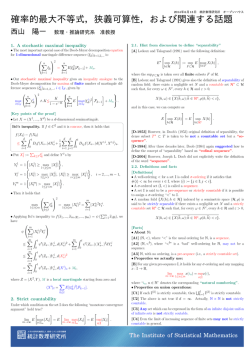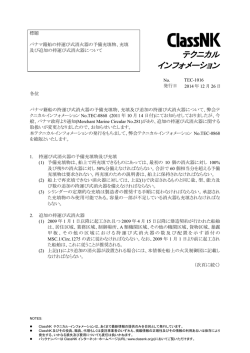
三日目のアブストラクト
フラクタル曲線と有向ネットワーク
村本克志 (河合塾)
関口健 (東北学院大)
Lebesgue の特異関数をそのパラメターで微分すると Takagi 関数になることは, 畑-山口 [1] で指摘さ
れた. その後, 高次微分などの改良およびその応用が塩田, 岡田, 小林, 神谷, 我々等 [2],[3],[4],[5],[6],[7]
によりなされた. 本発表では、これらの結果を有向ネットワーク上に拡張する. また, それを用いて描け
るフラクタル曲線についてもふれる.
参考文献
[1] M. Hata and M. Yamaguti, The Takagi function and its generalization, Japan J. Appl. Math.,
1(1984), 183–199.
[2] T. Sekiguchi and Y. Shiota, A generalization of Hata–Yamaguti’s results on the Takagi function, Japan J. Indust. Appl. Math., 8(1991), 203–219.
[3] T. Okada, T. Sekiguchi and Y. Shiota, Applications of binomial measures to power sums of
digital sums, J. Number Theory, 52(1995), pp. 256–266.
[4] T. Okada, T. Sekiguchi and Y. Shiota, A generalization of Hata–Yamaguti’s results on the
Takagi function II: Multinomial case, Japan J. Indust. Appl. Math., 13(1996), pp. 435–463.
[5] Z. Kobayashi, Digital Sum Problems for the Gray Code Representation of Natural Numbers,
Interdisciplinary Information Sciences, 8(2002), 167–175.
[6] K. Muramoto, T. Okada, T. Sekiguchi and Y. Shiota, Power and exponential sums of digital
sums with information per digits, Math. Rep. Toyama Univ., 26(2003), 35-44.
[7] Y. Kamiya, T. Okada, T. Sekiguchi and Y. Shiota, Digital Sum Problems for Generlized Code
Systems, manuscript.
Real Analysis Symposium 2014
October 31st - November 2nd, 2014
Toyama University
On the generalized σ-Lipschitz spaces and
the generalized fractional integrals
Katsuo Matsuoka
College of Economics, Nihon University
November 2, 2014
For r > 0, let Qr = {y ∈ Rn : |y| < r} or Qr = {y = (y1 , y2 , · · · , yn ) ∈ Rn :
max1≤i≤n |yi | < r}, and for x ∈ Rn , let Q(x, r) = x + Qr = {x + y : y ∈ Qr }.
For a measurable set G ⊂ Rn , we denote the Lebesgue measure of G by |G| and
the characteristic function of G by χG . Further,Rfor a function f R∈ L1loc (Rn ) and a
1
f (y) dy and let
measurable set G ⊂ Rn with |G| > 0, let fG = −G f (y) dy = |G|
G
N0 = N ∪ {0}.
First, we recall the definitions of the non-homogeneous central Morrey space
p,λ
B (Rn ) and the λ-central mean oscillation (λ-CMO) space CMOp,λ (Rn ).
Definition 1. For 1 ≤ p < ∞ and −n/p ≤ λ < ∞,
(
)
Z
1/p
1
p
p,λ
n
n
p
B (R ) = f ∈ Lloc (R ) : kf kB p,λ = sup λ − |f (y)| dy
<∞ .
r≥1 r
Qr
On the other hand, we introduce the ”new” function space, i.e., the generalized
(d)
σ-Lipschitz space Lipβ,σ (Rn ) (see Nakai and Sawano (2012), M. (to appear); cf.
Komori-Furuya, M., Nakai and Sawano (2013)).
Definition 2. Let U = Rn or U = Qr with r > 0. For d ∈ N0 and 0 ≤ β ≤ 1, the
continuous function f will be said to belong to the generalized Lipschitz space on U ,
(d)
i.e., Lipβ (U ) if and only if
kf kLip(d) (U ) =
β
1
| 4d+1
f (x)| < ∞,
h
β
|h|
x,x+h∈U,h6=0
sup
where 4kh is a difference operator, which is defined inductively by
40h f = f,
41h f = 4h f = f (· + h) − f (·),
k−1
4kh f = 4k−1
h f (· + h) − 4h f (·), k = 2, 3, · · · .
Definition 3. For d ∈ N0 , 0 ≤ β ≤ 1 and 0 ≤ σ < ∞, the continuous function f
(d)
will be said to belong to the generalized σ-Lipschitz (σ-Lip) space, i.e., Lipβ,σ (Rn ) if
and only if
1
kf kLip(d) = sup σ kf kLip(d) (Qr ) < ∞.
β,σ
β
r≥1 r
In particular,
(0)
(d)
(0)
n
n
n
n
Lipβ,σ (Rn ) = Lipβ,σ (Rn ) and BMO(d)
σ (R ) = Lip0,σ (R ), BMOσ (R ) = BMOσ (R ).
Next we recall the definition of modified fractional integral I˜α .
Definition 4. For 0 < α < n,
Z
I˜α f (x) =
f (y)
Rn
1
1 − χQ1 (y)
−
|x − y|n−α
|y|n−α
dy.
Recently, in M. and Nakai (2011), from the Bσ -Morrey-Campanato estimate for
I˜α we obtained the following as the corollary.
Theorem 1 (M. and Nakai (2011); cf. Komori-Furuya and M. (2010)). Let 0 <
α < n, n/α < p < ∞ and −n/p ≤ λ < 1 − α. If β = α − n/p and σ = λ + n/p, then
I˜α : B p,λ (Rn ) → Lipβ,σ (Rn ).
Now we define the generalized fractional integral I˜α,d .
Definition 5. For 0 < α < n and d ∈ N0 , we define the generalized fractional
integral (of order α), i.e., I˜α,d , as follows : For f ∈ L1loc (Rn ),
Z
l
X x
l
˜
(D Kα )(−y) (1 − χQ1 (y)) dy,
f (y) Kα (x − y) −
Iα,d f (x) =
l!
Rn
{l:|l|≤d}
where
Kα (x) =
1
|x|n−α
and for x = (x1 , x2 , · · · , xn ) ∈ Rn and l = (l1 , l2 , · · · , ln ) ∈ Nn0 , |l| = l1 + l2 + · · · + ln ,
xl = xl11 xl22 · · · xlnn and Dl is the partial derivative of order l, i.e.,
Dl = (∂/∂x1 )l1 (∂/∂x2 )l2 · · · (∂/∂xn )ln .
Then as one of the results for a generalized fractional integral I˜α,d we can get
the following estimate on B p,λ (Rn ), which extends Theorem 1.
Theorem 2 ([M]). Let 0 < α < n, n/α < p < ∞, d ∈ N0 and −n/p + α + d ≤
λ + α < d + 1. If β = α − n/p and σ = λ + n/p, then
(d)
I˜α,d : B p,λ (Rn ) → Lipβ,σ (Rn ).
References
[M] K. Matsuoka, Generalized fractional integrals on central Morrey spaces and
generalized σ - Lipschitz spaces, in Current Trends in Analysis and its Applications: Proceedings of the 9th ISAAC Congress, Krak´ow 2013, Springer
Proceedings in Mathematics and Statistics, Birkh¨auser Basel, to appear.
A note on Herz type inequalities
Gaku Sadasue(Osaka Kyoiku University)
Let (Ω, F, P ) be a probability space, and {Fn∪
}n≥0 a nondecreasing sequence of sub-σ-algebras of F such that F = σ( n Fn ). The expectation
operalor and the conditional expectation operator relative to Fn are denoted
by E and En , respectively.
A sequence of integrable random variables f = (fn )n≥0 is called a martingale relative to {Fn }n≥0 if, for every n, fn is Fn measurable and satisfies
En [fm ] = fn
(n ≤ m).
If f ∈ Lp , p ∈ [1, ∞), then (fn )n≥0 with fn = En f is an Lp -bounded martingale and converges to f in Lp ([6]). For this reason a function f ∈ L1 and
the corresponding martingale (fn )n≥0 with fn = En f will be denoted by the
same symbol f .
We now introduce two martingale Hardy spaces. Let M be the set of
all martingale f = (fn )n≥0 relative to {Fn }n≥0 such that f0 = 0. Then the
maximal function of a martingale f are defined by
fn∗ = sup |fm |,
0≤m≤n
f ∗ = sup |fn |.
n≥0
Denote by Λ the collection of all sequences (λn )n≥0 of nondecreasing, nonnegative and adapted functions, and set λ∞ = limn→∞ λn . For f ∈ M and
0 < p < ∞, let
Λ[Pp ](f ) = {(λn )n≥0 ∈ Λ : |fn | ≤ λn−1 , λ∞ ∈ Lp }.
We define two martingale spaces by
Hp∗ = {f ∈ M : ∥f ∥Hp∗ = ∥f ∗ ∥p < ∞},
Pp = {f ∈ M : ∥f ∥Pp =
inf
(λn )n≥0 ∈Λ[Pp ](f )
∥λ∞ ∥p < ∞}.
We next introduce two martingale BMO spaces. For f ∈ L1 , let
∥f ∥BMO− = sup ∥En |f − En−1 f |∥∞ ,
n
∥f ∥BMO = sup ∥En |f − En f |∥∞ .
n
Then, we define two martingale BMO spaces:
BMO− = {f ∈ L1 : ∥f ∥BMO− < ∞},
BMO = {f ∈ L1 : ∥f ∥BMO < ∞}.
1
In [3], Herz discussed the duality between H1∗ and BMO− and proved the
following inequality for martingales:
|E[f φ]| ≤ 12∥f ∥P1 ∥φ∥BMO
(f ∈ L∞ , φ ∈ BMO).
This inequality is generalized by many authors.
In this talk, we give an extension of Herz type inequality with a different
proof.
References.
[1] C. Fefferman, E. M. Stein, H p spaces of several variables. Acta Math.
129 (1972), no. 3-4, 137–193.
[2] A. M. Garsia, Martingale inequalities: Seminar notes on recent progress.
Mathematics Lecture Notes Series. W. A. Benjamin, Inc., Reading,
Mass.-London-Amsterdam, 1973. viii+184 pp.
[3] C. Herz, Bounded mean oscillation and regulated martingales. Trans.
Amer. Math. Soc. 193 (1974), 199–215.
[4] S. Ishak and J. Mogyor´odi, On the PΦ -spaces and the generalization of
Herz’s and Fefferman’s inequalities. II. Studia Sci. Math. Hungar. 18
(1983), no. 2-4, 205–210.
[5] R. L. Long, Martingale spaces and inequalities, Peking University Press,
Beijing, 1993.
[6] J. Neveu, Discrete-parameter martingales, North-Holland, Amsterdam,
1975.
[7] F. Weisz, Probability theory and applications, 47–75, Math. Appl., 80,
Kluwer Acad. Publ., Dordrecht, 1992.
[8] F. Weisz, Martingale Hardy spaces and their applications in Fourier
analysis, Lecture Notes in Mathematics, 1568, Springer-Verlag, Berlin,
1994.
2
実解析学シンポジウム 2014 富山大学
Bwu (E)-関数空間の補間定理とその応用
曽布川拓也(早稲田大学グローバルエデュケーションセンター)
中井英一(茨城大学理学部)
The purpose of this talk is to introduce Bwu (E)-funciton spaces which unify many
function spaces, Lebesgue, Morrey-Campanato, Lipschitz, B p , CMO, local Morreytype spaces, etc. We investigate the interpolation property of Bwu (E)-funciton spaces
and apply it to the boundedness of linear and sublinear operators, for example, the
Hardy-Littlewood maximal operator, singular and fractional integral operators, and
so on, which contains previous results and extends them to Bwu (E)-funciton spaces.
© Copyright 2026



